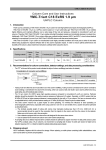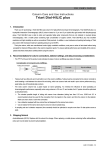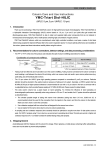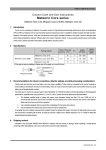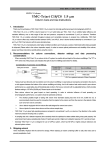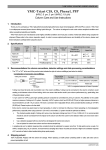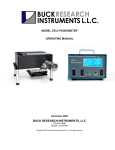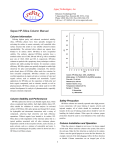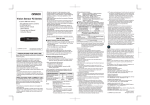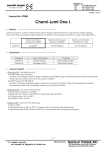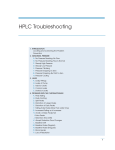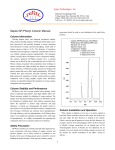Download Triart plus
Transcript
YMC USER'S MANUAL Column Care and Use Instructions Triart plus (Triart C18 plus, Triart C18 ExRS plus, Triart C8 plus, Triart Phenyl plus, Triart PFP plus) 1. Introduction Thank you for purchasing a YMC high-performance liquid chromatography (HPLC) column. Triart plus is a multipurpose reversed phase column using hybrid silica gel. Triart plus has excellent resolution and high durability as well as conventional Triart products. In addition, a new hardware and packing technology of Triart plus column offer increased maximum operating pressure up to 45 MPa. Triart plus column, which are manufactured under highly controlled conditions, must pass a series of strict tests before being accepted for shipment (Please refer to the column inspection report). To ensure optimal performance and durability of the column, please read these instructions carefully before using this column. 2. Specifications Packing material Particle size (µm) Pore size (nm) Triart C18 12 Triart C18 ExRS 8 Triart C8 Functional group C18 3, 5 Triart Phenyl C8 12 Triart PFP End capped Usable temperature range Regular use Upper limit (recommended) pH 1 – 7: 70 °C pH 7 – 12:50 °C 1.0 – 12.0 Yes Phenyl Pentafluorophenyl Usable pH range 20 – 40 °C 1.0 – 10.0 No 1.0 – 8.0 50 °C 3. Recommendations for column connections, detector settings, and data processing considerations ・ The "PTH" at the end of the product code indicates the style of column endfittings (see below for details). Consideration of connector and endfittings Tubing and connector Column The end of the product code Port depth Style of endfittings PTH ca. 2 mm / 0.09 inch Parker style Port depth ・ Tubing must have flat ends and must bottom out in the column endfitting. Tubing must be connected to the column correctly to avoid creating a void between the column frit and tubing, which can cause a leak and result in poor column performance (e.g. peak tailing, loss of theoretical plate number). ・ The extra column volume has a great impact on band spreading. To minimize the influence of band spreading on chromatographic performance, especially when using columns in 2.0 mm I.D. and smaller, the LC system should be optimized as described below. The shortest possible length of tubing with narrow inner diameters (tubing less than 0.15 mm, 0.006 inch I.D. is recommended) should be used for the connection from the injector to the column and from the column to the detector. Make sure not to have a void in the connection. Use a detector equipped with low-volume flow cell designed for the narrow bore column. Use an injector for the narrow bore column and a low-volume sample loop. ・ A sampling rate and a detector response (time constant) should be optimized to acquire more than 10 data points across a peak. (UM141119AE) 1/2 YMC USER'S MANUAL 4. Shipping solvent 100% Acetonitrile. Replace with this solvent for storage. When replacing a mobile phase containing buffer salts/additives, extra care must be taken to prevent salt precipitation. 5. Precautions for use ・ The correct direction of the solvent flow is indicated by an arrow on the column identification label. ・ Do not disconnect a column from the LC system before the pressure drops to zero. ・ The column pressure limit and recommended flow rate are the following. Usable pressure range Particle size 3 µm, 5 µm Regular use (recommended) Upper limit 30 MPa or less than 30 MPa 45 MPa Column I.D. and recommended flow rate (Mobile phase condition : acetonitrile/aqueous solution) 2.1 mm I.D. : 3.0 mm I.D. : 4.6 mm I.D. : 0.2 mL/min 0.4 mL/min 1.0 mL/min Avoid using a column repeatedly near the pressure limit or abrupt change in pressure to prevent shortening of the column life. Adjust the flow rate appropriately because the pressure changes depending on the column length, temperature, types of organic solvent etc. ・ Aqueous or non-aqueous solvents can be used as a mobile phase. Repetitive replacement among solvents with large difference in polarities might degrade the column performance. In general, acetonitrile, methanol and tetrahydrofuran (THF) are recommended for regular use (Please also see the recommendation above under alkaline mobile phase conditions). When using THF as a mobile phase, be mindful of the solvent resistance of your system or tubing (PEEK parts are especially unsuitable for use with THF). ・ Recommendations of pH and temperature for column use are shown in the specifications table in section 2. In addition, please note the following. Column lifetime varies depending on conditions of use such as pH, temperature and mobile phase composition. In general, usage at higher temperatures, higher concentrations of buffer salts/additives and lower concentrations of organic solvents can shorten the column lifetime. When using the column under alkaline conditions for a long time, a column should be used with a low concentration (about 1 – 10 mM) of organic buffer, such as triethylamine or glycine, at a lower temperature (less than 30 °C). The mobile phase containing methanol is expected to give a longer column lifetime under alkaline conditions than other organic solvents will. ・ Make sure of the miscibility among the organic solvents and take care to prevent the precipitation of buffer salts/additives to avoid overpressuring the column. ・ When possible, the sample should be dissolved in a solvent that is of the same composition as the initial mobile phase. Using a stronger solvent than the initial mobile phase for sample dissolution might result in distorted peak symmetry and degraded resolution. ・ To prevent exposure of the column to excessive pressure, the mobile phase and sample solution should be filtered through a 0.2 µm membrane or smaller to remove particulates. 6. Column cleaning (general method) [After using mobile phase not containing buffer salts/additives] ・ Flush the column with solution containing a higher ratio of organic solvent for washing out the compounds that have a great capacity for retention in the column. ・ Usable concentration of organic solvent is up to 100%. A cleaning solution containing THF might be effective when removing highly hydrophobic (lipid-soluble) substances that are adsorbed onto the gel. [After using mobile phase containing buffer salts/additives] ・ First replace with a water/organic solution containing no buffer salts or additives (A ratio of water to organic solvent should be set at the same proportions as a mobile phase). Then flush the column in accordance with the method described above. [General proposals] ・ Flushing with 100% water after using the column around the pH limit might shorten column lifetime. Flush the column with water/organic solution as described above. ・ Once macromolecules such as proteins or polysaccharides are adsorbed onto the gel, they are hardly removed, even if solvents with high eluting capability are used. To avoid contamination of the column by them, conduct sample pretreatment carefully before introduction into the column. Alternatively, use a guard column. YMC Karasuma-Gojo Bldg., 284 Daigo-cho, Karasuma Nishiiru Gojo-dori, Shimogyo-ku, Kyoto 600-8106, Japan TEL +81-75-342-4515 FAX +81-75-342-4550 URL:www.ymc.co.jp E-Mail:[email protected] (UM141119AE) 2/2



